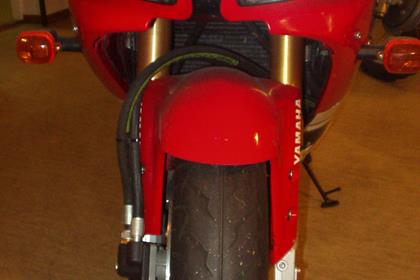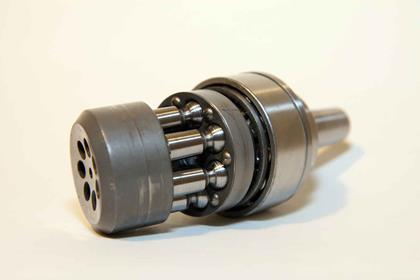Secrets of Ohlins' 2-wheel drive R1 revealed
Ohlins’ 2WD project manager reveals: it was faster dry or wet, suffered only a 2.5bhp power loss, and that there were four manufacturers who had Ohlins 2WD-equipped mules.
This is an extended version of a story which appeared in MCN in April.
A week before he retires, Lars Jansson – Öhlins’ R&D manager of future projects and the man behind the would-be revolutionary 2-wheel-drive system – is at last free to tell its secrets, and reveal it remains in a high state of production-readiness.
How did the two-wheel-drive (2WD) project begin?
Yamaha had been interested in 2WD since the late 80s. In the early 90s they asked us to investigate the best method and we suggested a small high-speed pump above the gear box and a small high-speed hydraulic motor in the front hub with a reduction gear. Yamaha then asked us, please build it. By the time we presented the first crude prototype in March 1993 we were quite enthusiastic.
How did development progress?
We devoted around a third of our future projects department to 2WD. The first date we went public was on a motocross bike in the Swedish Gotland Grand National in 1998. In 1999 we built two Yamaha TT600R bikes, but by this time Yamaha seemed to be losing interest in using the system exclusively because they felt the system was more of an add-on than part of a bike’s original build. So we started to pursue opportunities to interest other manufacturers in it. This is why we allowed the R1 to be ‘leaked’ in 2001. We told the rider to make himself obvious while testing in Spain.
Is it true the system only works when the rear wheel is slipping?
Yes. But the only time you have no rear-wheel slip on motorcycle is when you are pushing the bike. If you are riding, even at a constant speed, then you have a small slip. Before rubber transmits any drive at all it deforms. At 80kmh you have maybe 0.5% slip. At full throttle at 200kmh you have as much as 5% slip. At 5% spin there is roughly 160bar pressure in the system [system is pre-pressurised to 2-3 bar at rest].
In a corner, because of the different width in tyres front and rear, the rear wheel rotates faster than the front and this pressurises the system too, sending more power to the front. It works as hard at a constant speed in a corner as when accelerating at full throttle in a straight line. The effect is to drag the bag into the apex in a very different way to a rear-wheel-drive [RWD] bike. Turning the throttle in a bend on a RWD bike causes the bike’s front to lift and the bike to understeer. With 2wd the behaviour is completely different – the more you accelerate the more tightly the bike begins to turn.
What were the performance benefits?
Stability and cornering. Accelerating hard in a straight line the 2WD bike tracked straighter, with less chance of wheelying. But if you did provoke it into a wheelie it was much more easy to control – the spinning wheel creates gyroscopic stability to balance the whole bike. In the corners testers found they could accelerate harder round corners with none of the understeer that would normally cause. Just overcoming the rolling resistance of the front wheel helps the stability in all conditions. The R1 was 5 seconds faster in the wet at Kelskoga track. But it was between 1 and 2 sec faster in the dry too. The press has focused on advantages for novice riders, and this is true off-road. But on-road the more experienced you are the more benefits you can exploit. The more aggressively you ride it, the closer you dare to be to the limit, the more you stand to gain.
Which other manufacturers were interested?
Four manufacturers from Japan and Europe were very interested. We visited their factories to demonstrate the 2wd R1 and TT600R, and we came away with some of their machines to convert to 2wd for them to evaluate – everything from sportsbikes to tourers.
What was the response from the manufacturers?
Most of their test riders were impressed by the system on the R1. Most were going faster in the dry as well as the wet thanks to increased corner speed. But it altered the bike’s character from very crisp and urgent, into something more relaxed. Not slower, but easier to drive through corners and less ‘frisky’. It was a little heavier to turn in chicanes.
By 2004 we had the manufacturers’ bikes ready for evaluation – a tourer, a sportsbike equivalent to the R1, an adventure bike and another off-road bike. We thought the system added performance to all of them. They then took them away and as far as I know they still have them. Waiting to hear back was like waiting to hear from a girlfriend who has gone away. Unfortunately we heard very little.
What went wrong?
In 2004 we produced with Yamaha the WR450 2-Trac, with a run of 250 units. But demand was low because the price of such a limited run is high, and it was never homologated for the road. It was very frustrating to watch that bike fail. We continued to develop the technology for two years, until 2007, and had a new generation ready. But after the 2-Trac there wasn’t the demand. If that bike had succeeded we would have two-wheel-drive Yamahas and perhaps from other manufacturers today.
Could it be revived?
Yes, up until 2007 we had developed four ‘next generation’ systems, one for each type of bike, and with different ways for adjusting the power delivery to the front wheel. We have stopped development work, but we have never said this project is closed. If a customer comes to us to discuss two-wheel drive we could resume work very quickly.
How accurate was press coverage of the technology?
We never tested at the Nurburgring. We tested at some tracks in Italy in association with a manufacturer and we tested in Spain and extensively at Karlskoga, a bumpy Swedish track.
The quoted weight of 8kg additional weight was about right. Power up to 15% could be transferred to the front wheel, that was right too. But people were wrong about the power losses – it was only about 2.5bhp at 150kmh.
Where is the R1 now?
We made two R1s – one of which is still in our workshop and one Yamaha has.
Why haven’t we got 2WD in MotoGP, where traction is at a premium?
I have no answer. I think it would be beneficial.
Will Öhlins produce kits?
Technically it’s possible to make the system work as a kit for after-market application and we have looked at this, but it is not economic. And as bikes continued to develop the space available for the pump became less and less.
Do you have any regrets over the years you spent on 2WD?
Not at all. It’s been very rewarding technically, we’ve met a lot of people in other manufacturers because of it and we have a product that is production worthy. And we are a little bit proud of it also. It is not the product that has fallen asleep, but the market.










